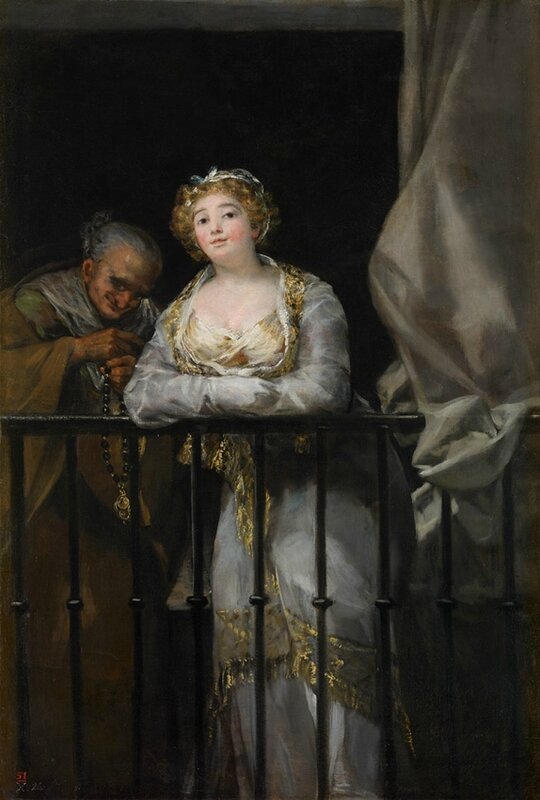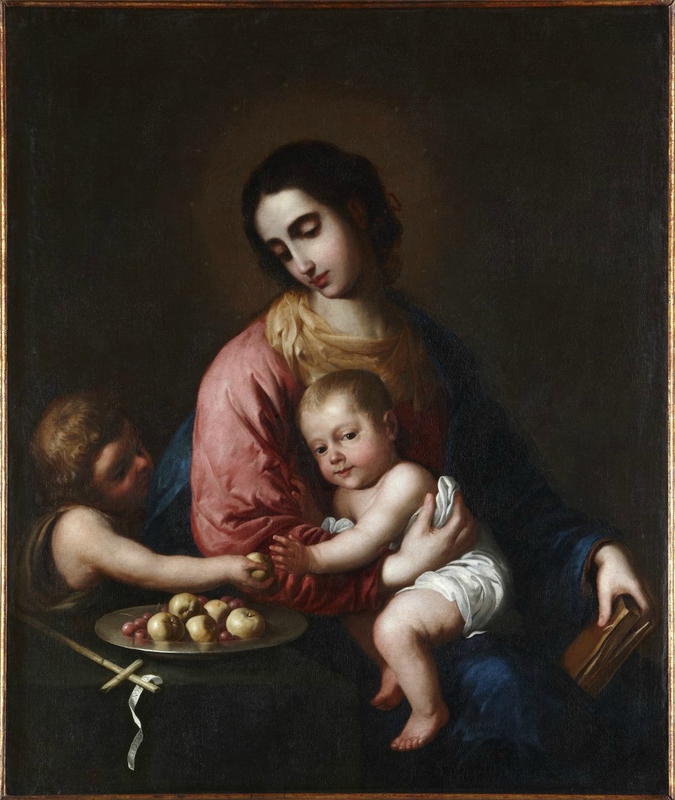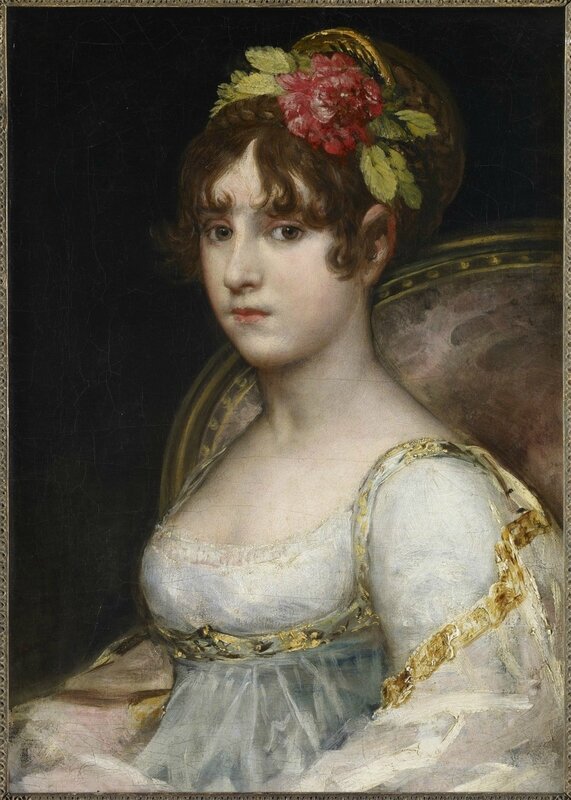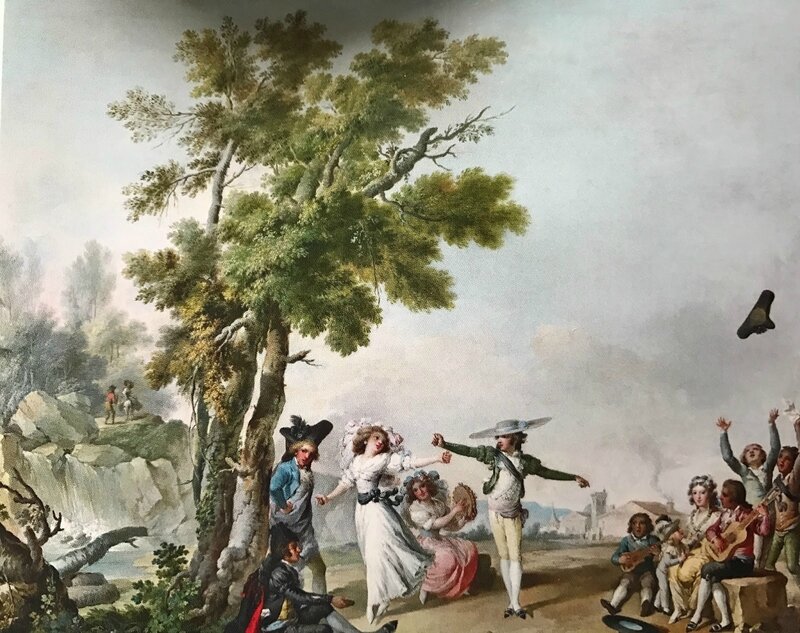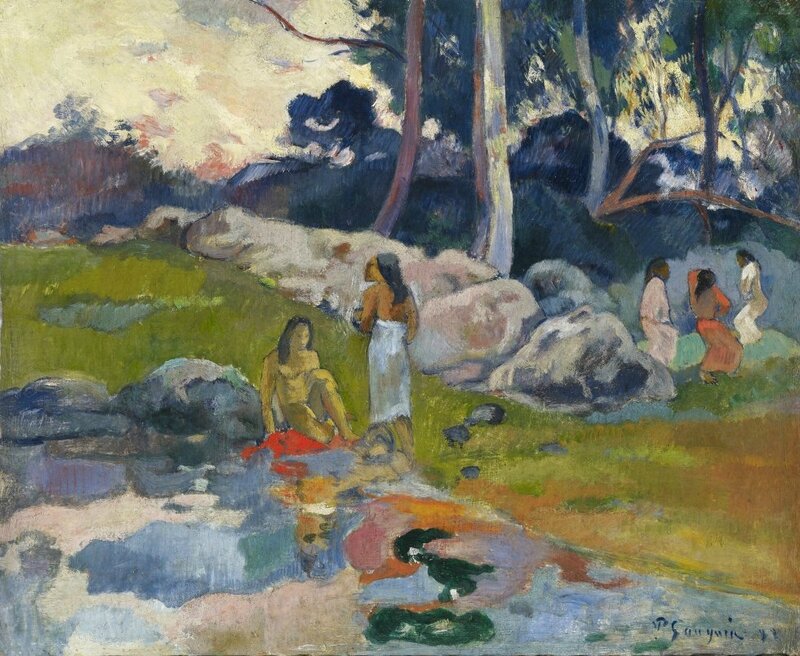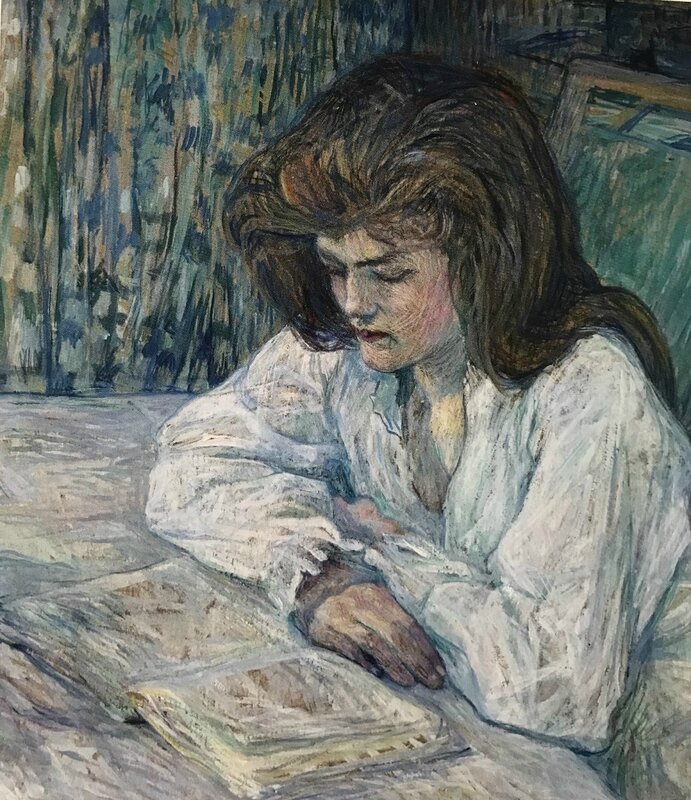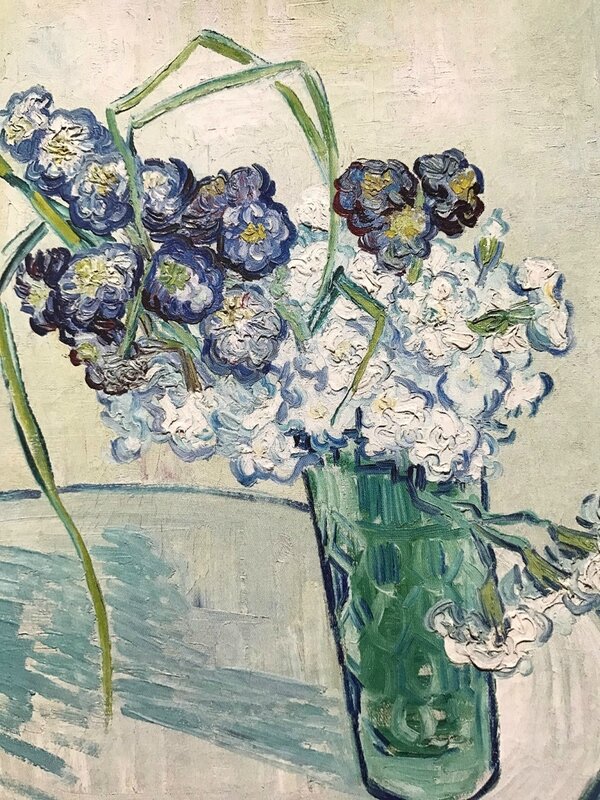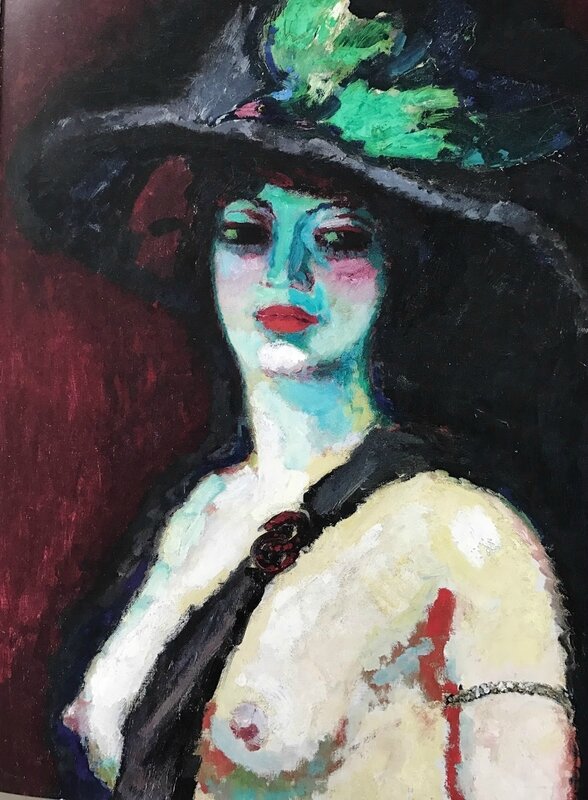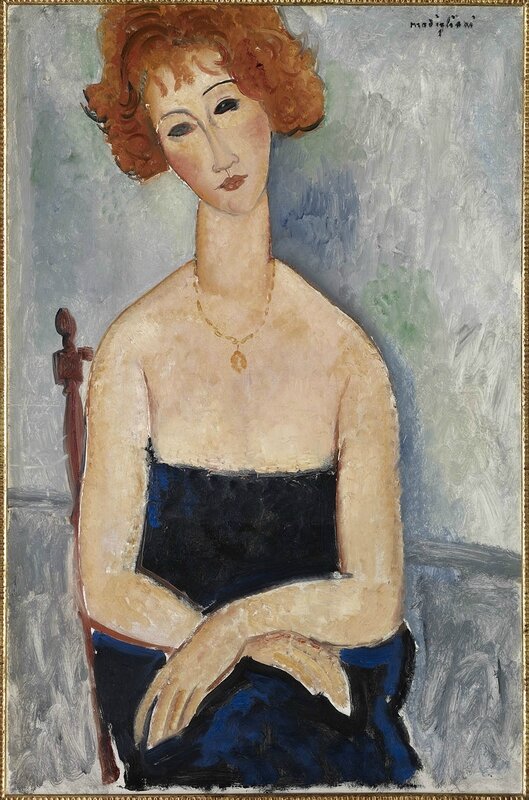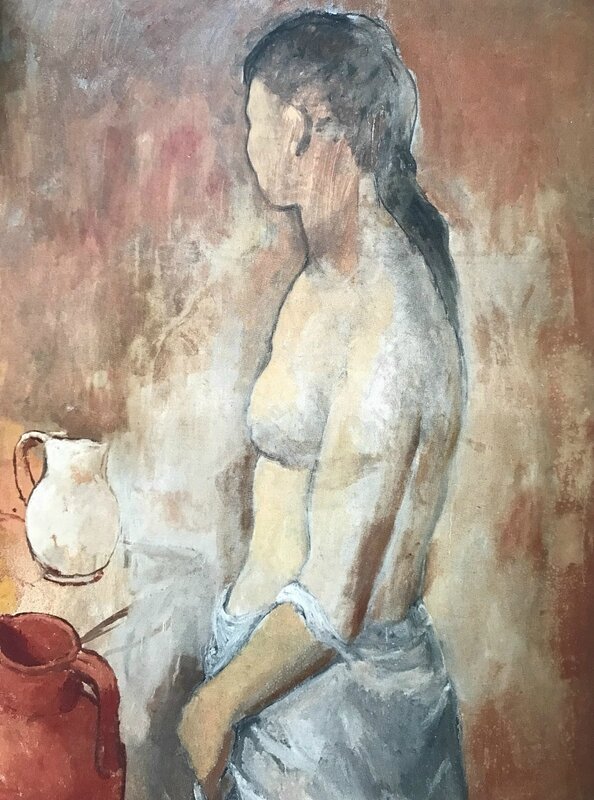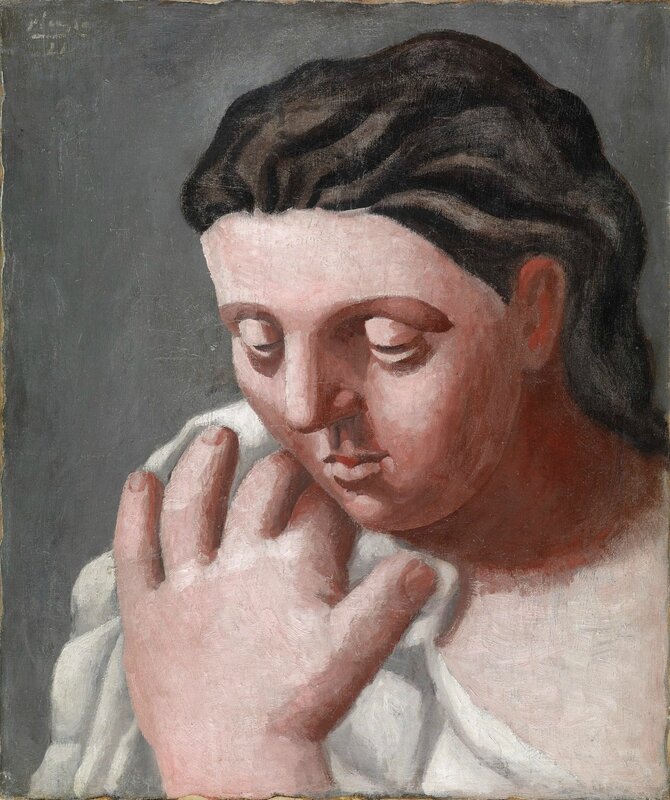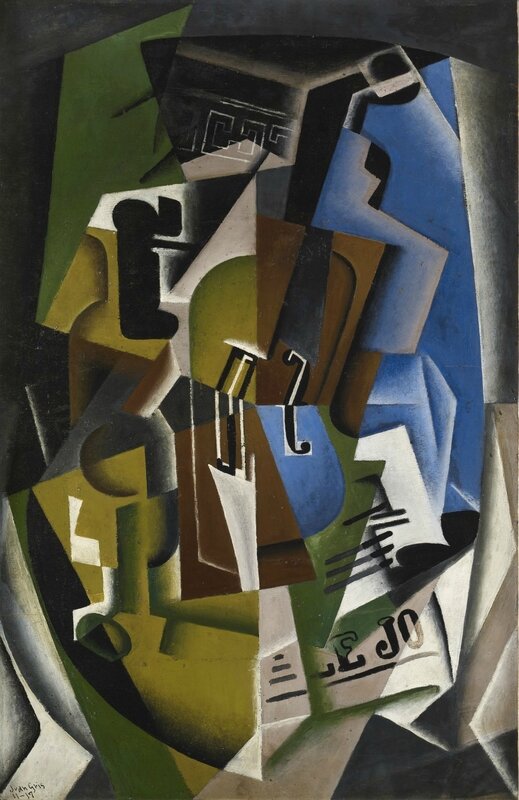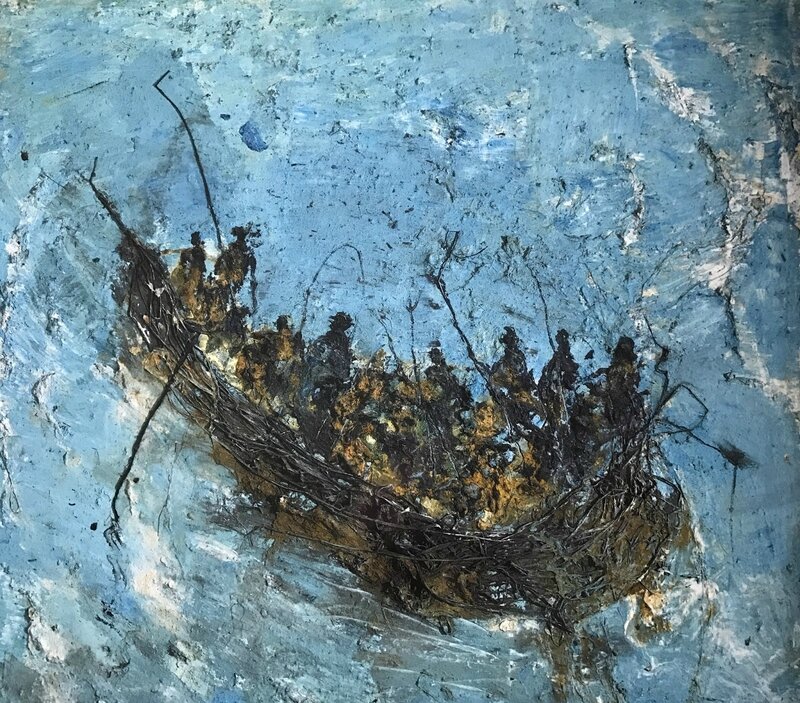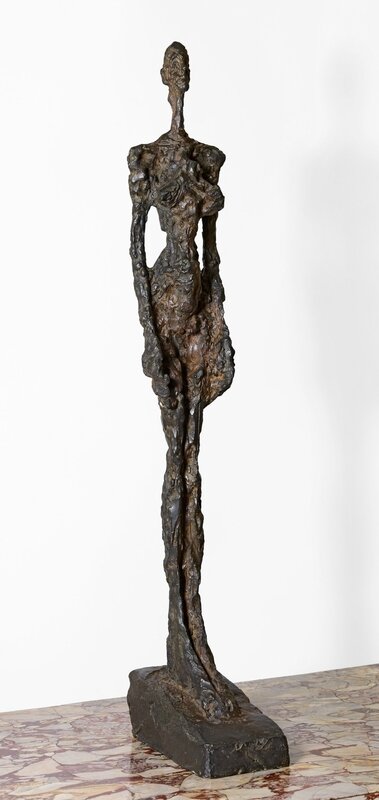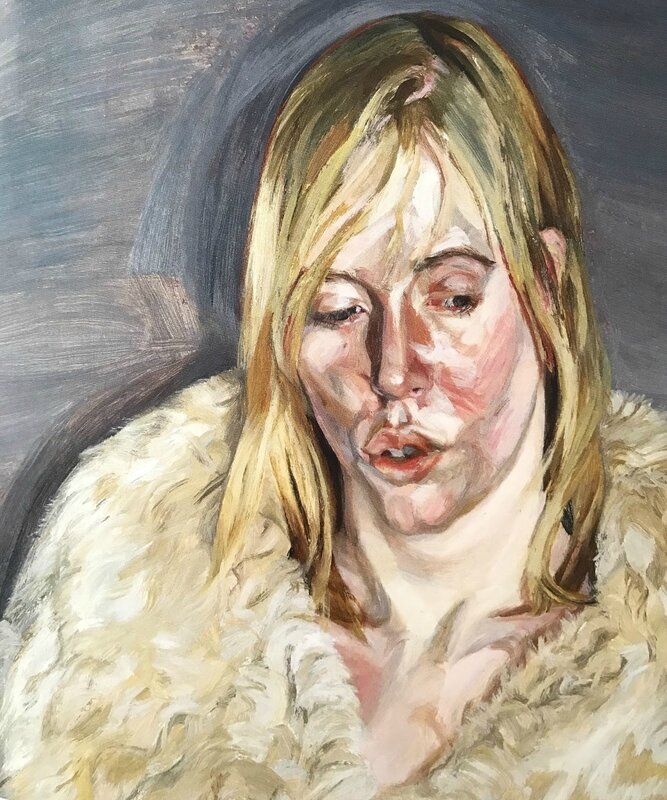Plate, Qing dynasty, Qianlong mark and period (1736–95)
Vase, Qing dynasty, Qianlong mark and period (1736–95)
A magnificent celadon-glazed carved baluster vase, Qianlong seal mark in underglaze blue and of the period (1736-1795)
Lot 1112. A magnificent celadon-glazed carved baluster vase, Qianlong seal mark in underglaze blue and of the period (1736-1795), 15¼ in. (38.7 cm.) high, box. Estimate USD 2,000,000 - USD 4,000,000. Price realised USD 7,922,500 © Christie's Images Ltd 2011
The tapering ovoid body rising to a sharp angle below the sloping shoulder that continues into the waisted neck below a galleried mouth rim, finely molded and carved with five registers of archaistic patterns including a broad band of wave pattern, bands of dragon or bird scroll and a lower band of pendent lappets enclosing C-scrolls, covered inside and out with a glaze of rich sea-green color thinning to a paler tone on the raised areas, the base similarly glazed.
Provenance: New England private collector; Sotheby Parke Bernet, New York, 17-18 1971, lot 140 (not illustrated).
Note: This rare and finely decorated vase is representative of the archaistic style frequently seen in porcelain vessels of Qianlong date. The interest of the Qianlong Emperor in archaic bronzes and antiques of all types influenced the efforts of the potters at the Imperial kilns to interpret the shapes and designs of early bronzes in porcelain.
The decoration and shape of the present vase was inspired by Western Zhou dynasty bronzes, such as the bronze lei dated to the 9th century BC, illustrated by John A. Pope et al., Freer Chinese Bronzes, vol. 1, Washington DC, 1967, pl. 83. (Fig. 1) Crisply cast bands of decoration similar to that of the broad wave-pattern band on the present vase can also be seen on the large bronze De Ke ding and on the Hu gui in the Shanghai Museum, illustrated by Chen Peifen in Ancient Chinese Bronzes in the Shanghai Museum, London, 1995, pp. 70-1, no. 43 and pp. 74-5, no. 46, respectively.
The present vase is also an excellent example of the effect that could be created by the use of the carved decoration on a monochrome porcelain vessel. The technique allows the details of the elaborate, crisp decoration around the body to be highlighted by the thin translucent glaze pooling in the deeper recesses to provide a contrast of color tones, thereby creating two shades of green, while accentuating the dense archaistic design.
A few other vases of this rare combination of shape and decoration, with Qianlong marks, are published. One by J. Ayers, Chinese Ceramics in the Baur Collection, vol. 2, Geneva, 1999, pl. 290 [A379], (Fig. 2) and again in Sekai Toji Zenshu, vol. 15, Tokyo, 1983, p. 111, pl. 121. One formerly in the T.Y. Chao Collection, was sold in our Hong Kong rooms, 1 November 2004, lot 875. (Fig. 3) One in the Chang Foundation, Taipei, is illustrated by J. Spencer, Selected Chinese Ceramics from Han to Qing Dynasties, Taipei, 1990, pl. 155; and one in The Wang Xing Lou Collection is illustrated in Imperial Perfection: The Palace Porcelain of Three Chinese Emperors: Kangxi - Yongzheng - Qianlong, Hong Kong, 2004, p. 184, no. 68.
Christie's. Magnificent Qing Monochrome Porcelains and Earlier Works of Art from the Gordon Collection, 24 March 2011, New York
A very rare blue-glazed flask-form vase, Qianlong seal mark in underglaze blue and of the period (1736-1795)

Lot 1147. A very rare blue-glazed flask-form vase, Qianlong seal mark in underglaze blue and of the period (1736-1795), 12 in. (30.5 cm.) high, box. Estimate USD 2,000,000 - USD 4,000,000. Price realised USD 7,922,500 © Christie's Images Ltd 2011
The flattened globular body raised on a spreading pedestal foot of oval section, and molded on each side with a slightly raised panel of corresponding shape with central indentation at the top, with a pair of bird-form handles applied below the rounded shoulders on the narrow sides, and with a raised band at the base of the cylindrical neck, the interior glazed white.
Provenance: Sotheby Parke Bernet & Co., London, 29 March 1977, lot 285.
Sotheby Parke Bernet Inc., New York, 6 November 1981, lot 315.
Note: This rare and finely decorated vase is representative of the archaistic style frequently seen in porcelain vessels of Qianlong date. The intThis rare vase is representative of the archaism frequently seen in porcelain vessels of Qianlong date. The interest of the Qianlong Emperor in archaic bronzes and antiques of all types influenced the efforts of the potters at the Imperial kilns to interpret the shapes and designs of early bronze and ceramic wares in porcelain.
The very unusual flask form of this vase appears to be a Qing dynasty interpretation of ancient prototypes made of bronze, pottery and stoneware. Bronze vessels of this flattened hu shape, bianhu, were an innovation of the Eastern Zhou dynasty, circa 400 BC, and continued to be made into the Han dynasty. A silver-inlaid bronze example of Warring States date (late 4th-early 3rd century BC) is illustrated by T. Lawton in the exhibition catalogue, Chinese Art of the Warring States Period, Change and Continuity, 480-222 B.C., Freer Gallery of Art, 1982, pp. 46-7, no. 10. This vessel has flat sides, is raised on a low rectangular foot and has a waisted neck. By the Han dynasty, bronze bianhu had a more tapering body shape and had acquired raised panels on the sides that followed the shape of the flask and had an indentation at the top of the panel. A bronze bianhu of this type, with body shape similar to that of the Gordon vase, raised panels on the sides, and spreading oval foot, is illustrated in Kandai no Bijutsu, Osaka Museum of Art, 1974, p. 24, no. 2-21. It is 27.2 cm. high and has small ring handles on the shoulder. The neck is somewhat flared, and not as cylindrical as that of the Gordon vase. Also illustrated, p. 3, no. 1-17, is a grey pottery flask (30 cm. high), modeled in imitation of the bronze prototypes, with a somewhat more rounded body, raised on a flared rectangular foot, and with small loops applied on the shoulders either side of the base of the cylindrical neck.
During the Jin dynasty, 3rd-4th century, this bianhu shape was being made in stoneware at the Yue kilns. Two such excavated examples are illustrated by Jan Fontein and Tung Wu in Unearthing China's Past, Museum of Fine Arts, Boston, 1973, p. 135, figs. 65 and 66. Also illustrated, p. 134, no. 63, is a Yue ware bianhu in the Charles B. Hoyt Collection, Museum of Fine Arts, Boston, which has a body shape similar to the excavated examples, as well as the present vase, but is missing the distinctive pedestal foot, as it had been broken off at some time in the past and the base had been polished down. Another Yue bianhu, with foot intact, from the estate of Walter Hochstadter, was sold in these rooms, 19 March 2009, lot 502. (Fig. 1) The sides of the Yue examples are flat, but the outline of the raised panels of the Han prototypes is indicated by narrow bands of punched circles. Unlike the Han prototypes, the Yue bianhu have pairs of loop handles on the narrow sides, rather than the single loops on the shoulder of the Han vessels, and the applied mask and ring handles of the Warring States vessel.

A rare Yueyao celadon flask, Western Jin dynasty, late 3rd-4th century, 10 in. (25.5 cm.) high. Sold for USD 7,500 at Christie's New York, 19 March 2009, lot 502. © Christie's Images Ltd 2009
Not only the shape of the body and the distinctive pedestal foot, but also the shape of the molded panels on the sides of the present blue-glazed vase are based on the earlier prototypes. The bird-form handles are a fanciful Qing dynasty alternative to the small double loop handles applied on the narrow sides of the Yue flasks, and the single loops of the Han vessels.
Qing vases of this unusual shape appear to be quite rare, and of those published, all are monochromes. Two in the collection of the Palace Museum in Beijing are illustrated in Kangxi. Yongzheng. Qianlong: Qing Porcelain from the Palace Museum Collection, Hong Kong, 1989: a celadon-glazed example, Yongzheng mark and period, p. 273, no. 102, (Fig. 1) and a flambé-glazed example with a cover surmounted by a recumbent mythical beast, Qianlong mark and period, p. 450, no. 132. (Fig. 2) Another with teadust glaze is illustrated by J. Ayers, Far Eastern Ceramics in the Victoria and Albert Museum, London, 1980, no. 216. These and the present vase attest to the ability of the artists working at the Imperial kilns to interpret ancient prototypes in porcelain, making of them something completely new.
Christie's. Magnificent Qing Monochrome Porcelains and Earlier Works of Art from the Gordon Collection, 24 March 2011, New York
A very rare blue-glazed slender baluster vase,ganlanping, Yongzheng mark and period (1723-1735)

Lot 1157. A very rare blue-glazed slender baluster vase, ganlanping, Yongzheng six-character mark in underglaze blue within a double circle and of the period (1723-1735), 16¼ in. (41.3 in. ) high, box. Estimate USD 800,000 - USD 1,200,000. Price realised USD 4,562,500 © Christie's Images Ltd 2011
The elegant rounded body tapering towards the slightly spreading foot and towards the waisted neck that rises to a flared rim, the exterior covered with a rich blue glaze in contrast to the white rim and interior.
Provenance: Sotheby Parke Bernet, New York, 21 November 1974, lot 324, and illustrated on the cover.
Note: Vases of this unusual shape, ganlanping, or olive-shaped, are quite rare, and appear to be especially rare in monochrome glazes. The form was admired in all three of the great imperial reigns of the Qing dynasty - Kangxi, Yongzheng and Qianlong. During the Kangxi period the shape was more attenuated, with a more slender neck and less flared mouth, unlike the shape of the present vase. Two vases which exemplify the Kangxi shape, each incised with decoration under a pale blue glaze, are illustrated by J. Ayers, The Baur Collection, vol. 3, Geneva, 1972, no. A 326, which has a straight neck and no flare to the foot, and no. A 328, which has a tall slender neck rising to a slightly everted mouth rim.
The somewhat more robust shape seen in the Yongzheng and Qianlong period has a shorter neck and more widely flared mouth, as well as a slight flare at the foot. This is the elegant shape seen in the Gordon vase and others bearing Yongzheng marks that have been published, all of which are variously decorated. A blue and white example in the Palace Collection, Beijing, illustrated in Qingdai Yuyao ciqi, vol. 1, Beijing 2005, pp. 80-1, no. 29, is the most similar in shape to the present vase, as well as in size (39.9 cm.). Another in the Palace Collection, Beijing, decorated in green on a yellow ground, illustrated by Feng and Geng (eds.), Selected Porcelain of the Flourishing Qing Dynasty at the Palace Museum, Hong Kong, 1994, p. 197, no. 43, is also very similar in shape. Two monochrome-glazed examples, also in the collection of the Palace Museum, are also illustrated in Qingdai Yuyao ciqi, vol. 1, a copper-red-glazed vase, pp. 38-9, no. 9, and one covered with an imitation Guan glaze, pp. 342-3, no. 157. Both of these are somewhat smaller, 30.6 and 29.5 cm., and the neck is shorter. A monochrome white vase of comparable size (43 cm.) is illustrated by R. Krahl, Chinese Ceramics from the Meiyintang Collection, vol. 4 (II), London, 2010, pp. 316-7, no. 1779. See, also, the virtually identical blue-glazed vase, also with Yongzheng mark, sold at Sotheby's, London, 9 July 1974, lot 336.
Christie's. Magnificent Qing Monochrome Porcelains and Earlier Works of Art from the Gordon Collection, 24 March 2011, New York
A very rare Ge-type bronze-form vase, hu, Yongzheng seal mark in underglaze blue and of the period (1723-1735)

Lot 1120. A very rare Ge-type bronze-form vase, hu, Yongzheng seal mark in underglaze blue and of the period (1723-1735), 12¾ in. (32.4 cm.) high. Estimate USD 400,000 - USD 600,000. Price realised USD 2,042,500 © Christie's Images Ltd 2011
Of pear shape, molded with two double bow-string bands below a pair of lug handles that flank the neck, with a very slight raised edge on the lower body above the spreading foot which is encircled at the top by a single bow-string band, covered overall with a pale, very slightly greenish-grey glaze suffused with an irregular pattern of dark grey ('iron wire') crackle, the unglazed bottom of the foot covered with a brown dressing.
Provenance: Cunliffe Collection, no. PC 20.
Sotheby's, New York, 4 December 1985, lot 256..
Note: Both the shape and the glaze of this rare vase are based on Song dynasty wares, which were greatly admired by the emperors of the high Qing. During the Yongzheng reign much research and development was undertaken in order to reproduce the glazes of these wares on porcelains made at the imperial kilns at Jingdezhen.
The pear shape, lug handles and bow-string bands decorating the neck and body appear to have been inspired by Longquan, as well as Ge and Guan ware prototypes. The circular hu shape of the present vase is more similar to that of Longquan celadon examples, such as the vase in the Qing Court collection, illustrated in The Complete Collection of Treasures of the Palace Museum - 33 - Porcelain of the Song Dynasty (II), Hong Kong, 1996, p. 114, no. 102, which is of comparable size (31.5 cm.). Another Longquan celadon vase of this type is illustrated by Liu Liang-yu, A Survey of Chinese Ceramics - 2 - Sung Wares, Taipei, 1991, p. 193. The shape of the present vase is, however, more robust and rounded than the Song Longuan vases.
The grey glaze suffused with dark grey crackle was inspired by the glaze found on Ge wares of Southern Song and Yuan date. The hu-form vases on which Ge and Guan glazes were found were of oval, rectangular, or faceted shape. Two small (13.4 and 14.8 cm. high) vases described as Ge ware, of oval hu shape, with lug handles joined by two bow-string bands, are also illustrated by Liu Liang-yu, op.cit., A Survey of Chinese Ceramics - 5 - Sung Ceramics, pp. 200-1. See, also, a larger Guan ware vase (10 in.) of this type in the collection of Mrs. Alfred Clark, included in the Oriental Ceramic Society exhibition, Ju and Kuan Ware, London, 12 - 13 December 1952, no. 34. A larger Ge ware vase (24.1 cm.) of faceted octagonal hu form, also with lug handles joined by bow-string bands, is illustrated op. cit., The Complete Collection of Treasures of the Palace Museum - 33 - Porcelain of the Song Dynasty (II), p. 45, no. 39, and a Guan ware vase (23 cm. high), of oval section, is illustrated pp. 6-7, no. 3.
The combination of shape and glaze of the present vase is extremely unusual, and a most successful Qing interpretation of the antique.
Christie's. Magnificent Qing Monochrome Porcelains and Earlier Works of Art from the Gordon Collection, 24 March 2011, New York
A celadon-glazed double-gourd vase, Qianlong seal mark in underglaze blue and of the period (1735-1796)

Lot 1135. A celadon-glazed double-gourd vase, Qianlong seal mark in underglaze blue and of the period (1735-1796), 13 in. (33 cm.) high. Estimate USD 150,000 - USD 250,000. Price realised USD 602,500 © Christie's Images Ltd 2011
Of pear shape, molded with two double bow-string bands below a pair of lug handles that flank the neck, with a very slight raised edge on the lower body above the spreading foot which is encircled at the top by a single bow-string band, covered overall with a pale, very slightly greenish-grey glaze suffused with an irregular pattern of dark grey ('iron wire') crackle, the unglazed bottom of the foot covered with a brown dressing.
Note: Double-gourd vases are also known as dajiping (vase of good fortune), as the double gourd, or bottle gourd, symbolizes fertility and good fortune.
A similar vase of the same size from the Nanjing Museum was included in the The Exhibition of Qing Imperial Porcelain of the Kangxi, Yongzheng, Qianlong Reigns, 1995, no. 69; and one is illustrated in Chinese Porcelain: The S.C. Ko Tianminlou Collection, vol. I, Hong Kong, 1987, pl. 106. Another is illustrated in Qing Imperial Monochromes: The Zande Lou Collection, Shanghai Museum, Beijing Museum, and Art Museum, The Chinese University of Hong Kong, 2005, pp. 118, no. 42. A similar vase with its original small stopper/cover from the Jingguantang Collection was sold in our Hong Kong rooms, 3 November 1996, lot 571, and again 28 October 2002, lot 723. See, also, the vase sold in our Hong Kong rooms, 31 May 2010, lot 2012.
The shape and color of the glaze of the present vase and the others like it appear to be a Qing interpretation of earlier Longquan celadon double-gourd vases of Song dynasty date, such as the example illustrated in Mayuyama, Seventy Years, vol. 1, Tokyo, 1976, p. 166, no. 484.
Christie's. Magnificent Qing Monochrome Porcelains and Earlier Works of Art from the Gordon Collection, 24 March 2011, New York
Bilbao Fine Arts Museum exhibits masterpieces from the collection of Alicia Koplowitz
Francisco de Goya y Lucientes, Maja and Procuress on the Balcony, 1808-1812 © Collection Alicia Koplowitz - Grupo Omega Capital.
BILBAO.- Over the past few decades the Alicia Koplowitz – Grupo Omega Capital Collection has become one of the most important art collections in Europe. Despite this, it has remained largely unknown with the exception of the recent display of around 50 works at the Musée Jacquemart-André in Paris.
The exhibition at the Bilbao Fine Arts Museum is an artistic event of the first order as for the first time it will introduce the visiting public to an extensive selection of works from this collection, based on an exceptional roll-call of great masters within the history of art. On display are a total of 90 paintings and drawings dating from the 16th to the 21st centuries, in addition to sculptures from classical antiquity to the present day.
In its entirety the selection of works reveals a distinctive approach to collecting marked by a quest for beauty that has led to a focus on both the past and present and which encompasses both painting and sculpture. These concerns are expressed through a particular presence of works from the 18th to the 20th centuries and through the desire to achieve an international scope, for which reason the collection includes both Spanish and international artists. These characteristics can be considered exceptional in the context of a private Spanish collection.
As Professor Francisco Calvo Serraller observes in his essay in the exhibition's accompanying catalogue, the works on display offer a survey of the history of western art, starting with classical antiquity and concluding in the present day, which is not structured around its principal periods or masters but rather through a selection guided by this collector's own taste.
The itinerary, which spreads across the museum's BBK room and the first floor of the building, is divided into nine sections: "The persistence of the classical ideal", "The century of the Englightenment", "The private and public realms", "Paris at the turn of the century", "New directions in interwar art", "Material, gesture and paint", "Figurations", "Informalist and abstract trends" and "Epilogue".
Starting with Greco-Roman sculpture, The Alicia Koplowitz – Grupo Omega Capital Collection reveals a particular interest in the modern and contemporary period but above all in the 18th and 20th centuries. In thematic terms it is characterised by a particular sensibility to the iconography of women, the earliest example of which is a statue of Aphrodite. This theme can be traced through all the different periods and artistic genres represented.
Within the context of 16th- and 17th-century Spanish painting, the interest in this iconography explains the presence of a court painting by Juan Pantoja de la Cruz, Portrait of doña Ana de Velasco y Girón, Duchess of Braganza, in Court Dress; Luis de Morales' depiction of the Virgin and her son, The Gypsy Virgin with the Christ Child with a Cross; and Francisco de Zurbarán's Virgin and Child with the Infant John the Baptist. Among the 17th-century paintings the genre of still life is also important, including a sumptuous Basket of Flowers by Juan de Arellano.
Juan Pantoja de la Cruz, Portrait of doña Ana de Velasco y Girón, Duchess of Braganza, in Court Dress, 1603. © Collection Alicia Koplowitz - Grupo Omega Capital.
Francisco de Zurbarán, Virgin and Child with the Infant John the Baptist, circa 1659 © Collection Alicia Koplowitz - Grupo Omega Capital.
Goya is the outstanding figure within the context of 18th-century works in the collection, with four paintings by the artist that reveal his wide range of interests: a scene of bandits, Assault on a Stage Coach; the mythological scene of Hercules and Omphale; the delicate Portrait of the Countess of Haro, its intimacy echoed in the portraits by Augustín Esteve and Luis-Léopold Boilly; and Maja and Procuress on the Balcony, an example of Goya's interest in picturesque scenes of daily life. The taste for genre scenes is also evident in works by other artists of this date who focused on similar themes and subjects, such as the examples by Lorenzo Tiepolo and the scenes of galanterie by Manuel Camarón and Luis Paret y Alcázar.
Francisco de Goya y Lucientes, Portrait of the Countess of Haro, 1802-1803 © Collection Alicia Koplowitz - Grupo Omega Capital.
Manuel Camarón y Melia, Majos dancing the bolero, 1795-1805. © Collection Alicia Koplowitz - Grupo Omega Capital.
Also notable within the same century is the genre of view painting, which reached a peak of expression among the Venetian painters Francesco Guardi and Canaletto. The topographical approach is evident in two panoramic views by Antonio Joli while the emphasis on picturesque ruins in a painting by Hubert Robert is characteristic of that French artist. More unusual is the presence of Pietro Antonio Rotari, whose depictions of four young women emphasise their states of mind.
The 19th century is represented by a refined composition by Raimundo de Madrazo and a particularly Post-Impressionist works by Gauguin, Toulouse-Lautrec and Van Gogh, the latter represented by a still life, a genre that was the speciality of Fantin Latour at the turn of the 19th and 20th centuries. Within the early 20th-century Parisian avant-gardes and Austrian Expressionism the Fauve painter Kees van Dongen, Egon Schiele and Amedeo Modigliani again reflect this collector's interest in the depiction of the female figure.
Paul Gauguin, Femmes au bord de la rivière, 1892. © Collection Alicia Koplowitz/Grupo Omega Capital
Henri de Toulouse-Lautrec, Young Girl Reading (La Liseuse), 1889.© Collection Alicia Koplowitz - Grupo Omega Capital.
Vincent Van Gogh, Vase with carnations, 1890. © Collection Alicia Koplowitz - Grupo Omega Capital.
Kees Van Dongen, Lady with large hat, 1906 © Collection Alicia Koplowitz - Grupo Omega Capital.
Egon Schiele, Woman in a Blue Dress, 1911. © Collection Alicia Koplowitz/Grupo Omega Capital.
Amedeo Modigliani, Red-headed Woman wearing a Pendant, 1918 © Collection Alicia Koplowitz/Grupo Omega Capital
With almost fifty works, the 20th century is another nucleus of the collection, representing half the exhibition. More than a third are by Spanish artists of international renown. Particularly notable are those by Picasso – two oils, a drawing and a small, painted metal sculpture – as well as Juan Gris and Luis Fernández, who participated in the dynamic years of the early avant-gardes in Paris, alongside the sculptors Pablo Gargallo and Julio González. By the latter is a wrought-iron sculpture and its preparatory drawing, two works that naturally relate to the later sculptures in the collection by Alexander Calder and David Smith.
Pablo Picasso, Demi-nu à la cruche, 1906. © Collection Alicia Koplowitz/Grupo Omega Capital. © Succession Picasso 2017
Pablo Picasso, Woman’s Head and Hand, 1921. © Collection Alicia Koplowitz/Grupo Omega Capital. © Succession Picasso 2017
Juan Gris, Violon et journal, 1917 © Collection Alicia Koplowitz/Grupo Omega Capital.
Moving forward to the 1940s, the works on display summarise many of the concerns of Spanish painters of this period including Antonio López, Manuel Millares and Antoni Tàpies; José María Sicilia represents the decade of the 1970s and there are also outstanding examples of the flourishing Basque sculpture of the period with creations by Jorge Oteiza and Eduardo Chillida. From the end of the century are two large-format paintings from the 1990s by Miquel Barceló and a sculpture by Juan Muñoz created in 2000.
Miquel Barceló, The Yellow lake, 1990. © Collection Alicia Koplowitz/Grupo Omega Capital.
Miquel Barceló, Kula Be Ba Kan, 1991. © Collection Alicia Koplowitz/Grupo Omega Capital.
Within mid-20th century European art the figurative trend is represented by the slender forms of Germaine Richier and Alberto Giacometti's sculptures and the angst-ridden portraits of Lucian Freud and Francis Bacon. The sole example of Pop Art is an iconic Self-portrait by Andy Warhol.
Alberto Giacometti, Femme de Venise I, 1956. © Collection Alicia Koplowitz - Grupo Omega Capital © Succession Alberto Giacometti (Fondation Alberto et Annette Giacometti)
Lucian Freud, Young Girl in a Fur Coat, 1967. © Collection Alicia Koplowitz/Grupo Omega Capital. © Lucian Freud Archive/Bridgeman Images.
From the same period, Nicolas de Staël's painting offers the counterpoint of abstraction, which defines another path in the collection through a selection of examples: Piet Mondrian's Neo-Plasticism; Lucio Fontana's Spatialism; Frank Stella, Donald Judd, Agnes Martin and Blinky Palermo's Minimalism; and Fausto Mellotti's "musical abstraction" are all important examples of this mode of expression.
American Abstract Expressionism finds its place with works by artists of the stature of Willem de Kooning and Mark Rothko as well as Cy Twombly from the following generation, its influence extending to Anselm Kiefer.
Willem de Kooning, Untitled IV, 1977. © Collection Alicia Koplowitz/Grupo Omega Capital. © The Willem de Kooning Foundation.
Mark Rothko, N°6 (Yellow, White, Blue over Yellow on Gray), 1954. © Collection Alicia Koplowitz/Grupo Omega Capital. © 1998 Kate Rothko Prizel & Christopher Rothko.
The most recently created work in the collection, dating from 2014, is in fact by Kiefer. Other key names whose work extends into the 21st century include Louise Bourgeois and Ai Weiwei, represented in the exhibition's impressive final section.
An unusual celadon-glazed carved bowl, Yongzheng six-character mark in underglaze blue within a double circle and of the period
Lot 1146. An unusual celadon-glazed carved bowl, Yongzheng six-character mark in underglaze blue within a double circle and of the period (1723-1735), 4½ in. (11.5 cm.) diam. Estimate USD 40,000 - USD 60,000. Price realised USD 314,500. © Christie's Images Ltd 2011
Of shallow rounded form, carved in low relief on the exterior with a continuous scrolling meander of a slender undulating stem bearing four flowers alternating with leaves above a band of delicate overlapping petals, with a flower head incised in the center of the interior, all under a glaze of pale blue-green tone thinning very slightly on the raised areas, the base similarly glazed.
Note: A very similar bowl, also with Yongzheng mark, is illustrated by R. Krahl, Chinese Ceramics from the Meiyintang Collection, vol. 2, London, 1994, pp. 202-3, no. 856; and another in the Ohlmer Collection, Roemer Museum, is illustrated by U. Wiesner, Chinesisches Porcelain, Mainz, 1981, p. 155, no. 87. See, also, the very similar bowl sold in these rooms, 16-17 September 2010, lot 1445.
An unusual celadon-glazed carved bowl, Yongzheng six-character mark in underglaze blue within a double circle and of the period (1723-1735), 4½ in. (11.5 cm.) diam. Sold for USD 74,500 at Christie's New York, 16-17 September 2010, lot 1445. © Christie's Images Ltd 2010
Christie's. Magnificent Qing Monochrome Porcelains and Earlier Works of Art from the Gordon Collection, 24 March 2011, New York
A copper-red-glazed pear-shaped vase, yuhuchunping, Qianlong seal mark in underglaze blue and of the period (1736-1795)
Lot 1144. A copper-red-glazed pear-shaped vase, yuhuchunping, Qianlong seal mark in underglaze blue and of the period (1736-1795), 11¾ in. (30 cm.) high. Estimate USD 80,000 - USD 120,000. Price realised USD 218,500. © Christie's Images Ltd 2011
With full, elegant body tapering towards the waisted neck which then flares out to the rim, the exterior covered in a glaze of dark cherry- red color ending at the white rim and in a neat line at a line of white glaze on the slightly spreading foot, the white glaze on the interior with a faint blue-green tint.
Note: Qianlong-marked vases of this type are included in the Illustrated Catalogue of Tokyo National Museum, Chinese Ceramics II, Tokyo, 1990, no. 697. Another from the Hellebronth and Bernheimer collections, was included in the exhibition, Chinesische Keramik, Museum für Ostasiatische Kunst, Cologne, 1988, no. 110. See, also, the slightly smaller vase (11 3/8 in.) sold in our Hong Kong rooms, 29 May 2007, lot 1530.
Christie's. Magnificent Qing Monochrome Porcelains and Earlier Works of Art from the Gordon Collection, 24 March 2011, New York
A fine copper-red-glazed yuhuchun vase, Seal mark and period of Qianlong (1736-1795)
Lot 2656. A fine copper-red-glazed yuhuchun vase, Seal mark and period of Qianlong (1736-1795), 29 cm., 11 3/8 in. Estimate 400,000 — 600,000 HKD. Lot sold 620,000 HKD. Photo: Sotheby's.
elegantly potted with a pear-shaped body, rising from a slightly splayed foot to a waisted neck and a flared rim, covered on the exterior with a rich red bubble-suffused glaze draining to white at the rims, the interior and base glazed white, the base inscribed in underglaze blue with a six-character reign mark.
Provenance: Mayuyama, Tokyo.
A Japanese Private Collection.
Christie's Hong Kong, 29th May 2007, lot 1530.
Sotheby's. Fine Chinese Ceramics & Works of Art, Hong Kong, 08 Oct 2010
An unusual Guan-type ribbed bottle vase, 19th century
Lot 1145. An unusual Guan-type ribbed bottle vase, 19th century, 16¼ in. (41.3 cm.) high. Estimate USD 10,000 - USD 15,000. Price realised USD 134,500. © Christie's Images Ltd 2011
Heavily potted, with lobed body below the plain cylindrical neck which is flanked by a pair of tubular lug handles, covered overall with a pale blue glaze suffused with wide golden-brown crackle that ends in a neat line on the brown-dressed unglazed foot ring, the base similarly glazed, with a Yongzheng seal mark on the base.
Note: A very similar vase of comparable size (16¾ in.) with Qianlong seal mark, and of the period, was sold in our Paris rooms, 14 June 2006, lot 365.
Christie's. Magnificent Qing Monochrome Porcelains and Earlier Works of Art from the Gordon Collection, 24 March 2011, New York
A rare carved Qingbai vase, meiping, Southern Song Dynasty, 12th century
Lot 1119. A rare carved Qingbai vase, meiping, Southern Song Dynasty, 12th century. A rare carved Qingbai vase, meiping, Southern Song Dynasty, 12th century, 9 in. (22.8 cm.) high. Estimate USD 12,000 - USD 18,000. Price realised USD 32,500. © Christie's Images Ltd 2011
The tapering ovoid body carved with three six-lobed medallions enclosing peony sprigs reserved on a rouletted ground, separated by small foliate scrolls, all between cloud collar-like borders above and below, covered with a glaze of pale blue tone continuing over the lipped rim.
Provenance: Bluett & Sons Ltd., London, 14 February 1989.
Note: The carved decoration on this meiping is very rare. However, a qingbai meiping of Southern Song date, carved with similar decoration, is illustrated in the catalogue for the exhibition, Two Thousand Years of Chinese Ceramics, Japan, 1992, p. 59, no. 50.
Christie's. Magnificent Qing Monochrome Porcelains and Earlier Works of Art from the Gordon Collection, 24 March 2011, New York
A Yueyao globular vase, Western Jin dynasty (265-317)
Lot 1104. A Yueyao globular vase, Western Jin dynasty (265-317). Estimate USD 2,000 - USD 4,000. Price realised USD 7,500. © Christie's Images Ltd 2011
The globular body raised on a spreading foot and encircled by bands of grooves and rings above three Buddha-form appliques, with a waisted neck and everted mouth with galleried rim, covered with a glaze of greyish-olive color; together with a small Yueyao compressed jar, Western Jin dynasty, impressed with a band of diamond pattern on the shoulder, raised on a shallow spreading foot, covered with a glaze of greyish-green color. Vase 5½ in. (14 cm.) high, jar 3 3/8 in. (8.5 cm.) across (2)
Provenance: Both: Sotheby's, New York, 15 June 1983, lot 140.
Christie's. Magnificent Qing Monochrome Porcelains and Earlier Works of Art from the Gordon Collection, 24 March 2011, New York
A painted grey pottery cocoon jar, Western Han dynasty, late 3rd-2nd century BC
Lot 1105. A painted grey pottery cocoon jar, Western Han dynasty, late 3rd-2nd century BC, 13½ in. (34.3 cm.) long. Estimate USD 3,000 - USD 4,000. Price realised USD 2,500. © Christie's Images Ltd 2011
The oblong body surmounted by a circular neck rising to an everted rim, painted in shades of pink, white and brick red with vertical bands of decoration, with bands of scrolls in pink and white within dark brick-red borders, with a red band encircling the shallow pedestal foot.
Provenance: In the Gordon Collection, United States, by 1997.
Note: A jar of this type excavated in Xinxiangxian, Henan province, is illustrated in Historical Relics Unearthed in New China, Beijing, 1972, pl. 87. Compare a similar jar with similar decoration illustrated by F. Klapthor, Chinese Ceramics, The Baltimore Museum of Art, 1993, p. 4; and another included in the exhibition, Spirit of Han, Ceramics for the After-Life, Southeast Asian Ceramics Society, Singapore, 1991, no. 17. See, also, the similar jar sold in these rooms from the Hardy Collection, 21 September 1995, lot 23 and again 18 September 2003, lot 196.
Christie's. Magnificent Qing Monochrome Porcelains and Earlier Works of Art from the Gordon Collection, 24 March 2011, New York
A large green-glazed red pottery jar, hu, Han dynasty (206 BC-AD 220)
Lot 1106. A large green-glazed red pottery jar, hu, Han dynasty (206 BC-AD 220), 17 3/8 in. (44 cm.) high. Estimate USD 3,000 - USD 4,000. Price realised USD 2,500. © Christie's Images Ltd 2011
Of pear shape, the shoulder molded with a hunting scene incorporating various fleeing animals, including a dragon, deer, tiger and several hunters, between bow-string borders and interrupted by a pair of applied, molded mask and ring handles, covered allover with a dark green glaze now iridesced to a gold and silvery color, the similarly glazed flat base with remains of three spur marks.
Provenance: Sotheby's, New York, 23 September 1995, lot 371.
Christie's. Magnificent Qing Monochrome Porcelains and Earlier Works of Art from the Gordon Collection, 24 March 2011, New York
A large painted grey pottery pear-shaped jar and cover, hu, Western Han dynasty, late 2nd-early 1st century BC
Lot 1107. A large painted grey pottery pear-shaped jar and cover, hu, Western Han dynasty, late 2nd-early 1st century BC, 23¾ in. (60.3 cm.) high. Estimate USD 4,000 - USD 6,000. Price realised USD 3,500. © Christie's Images Ltd 2011
The bulbous body painted in red, white and black with sweeping cloud motifs set between raised borders and interrupted by a pair of applied molded mask handles, the neck similarly painted below a band of pendent blades, raised on a pedestal foot, the domed cover painted en suite.
Provenance: In the Gordon Collection, United States, by 1997.
Note: This large painted jar and cover are quite similar in size and decoration to one illustrated by d'Argencé in the exhibition catalogue, Chinese Treasures from the Avery Brundage Collection, The Asia Society, New York, 1968, no. 56. Another is illustrated by R. Krahl in Chinese Ceramics from the Meiyintang Collection, London, 1994, vol. 1, p. 60, no. 70. The author notes that P.C. Sturman in 'Celestial Journeys - Meditations on (and in) Han Dynasty Painted Pots at the Metropolitan Museum of Art', Orientations, May 1988, pp. 54-67, interprets the cloud motif as the "celestial vapours through which the deceased would travel on their way to immortality", and illustrates a similar jar and cover, figs. 6-6b.
Christie's. Magnificent Qing Monochrome Porcelains and Earlier Works of Art from the Gordon Collection, 24 March 2011, New York
A rare straw-glazed figure of an equestrienne, Tang dynasty (618-907)
Lot 1109. A rare straw-glazed figure of an equestrienne, Tang dynasty (618-907), 14¾ in. (37.5 cm.) high. Estimate USD 4,000 - USD 6,000. Price realised USD 21,250. © Christie's Images Ltd 2011
The horse standing foursquare on a rectangular base, the female rider with left hand positioned to hold reins, wearing a wide-brimmed hat, a black scarf, a jacket with low-cut bodice over a long-sleeved blouse, and a long skirt under which she also wears pants, her hair worn in a long plait in back, with a quiver to her left side and a rolled cloth under her right arm where the long, tight sleeve can be seen to cover her hand, with traces of black, red, blue and green pigment on the yellowish-green straw glaze.
Provenance: Sotheby's, New York, 4 June 1982, lot 96.
Note: A painted straw-glazed pottery figure of an equestrienne of this type, wearing a similar hat over a black scarf, and similar riding costume, is illustrated by James C.Y. Watt et al., China: Dawn of a Golden Age, 200-750 AD, The Metropolitan Museum of Art, 2004, p. 291, no. 183. The figure was excavated from the tomb (dated 664) of Zheng Rentai, at Liquan, Shaanxi province, in 1971. The hat the rider is wearing is identified as a weimao. Another similar figure with the same long, narrow sleeves, also wearing a weimao hat over a scarf, was included in the Oriental Ceramic Society exhibition, The Arts of the T'ang Dynasty, London, 1955, pl. 33 (bottom right).
Christie's. Magnificent Qing Monochrome Porcelains and Earlier Works of Art from the Gordon Collection, 24 March 2011, New York
A superb and rare parcel-gilt silver leys jar, Tang dynasty, 8th-9th century
Lot 73. A superb and rare parcel-gilt silver leys jar,Tang dynasty, 8th-9th century, 10.9cm., 4 1/4 in. Estimate 70,000 — 90,000 GBP. Lot sold 264,500 GBP. Photo: Sotheby's.
of compressed globular form resting on a splayed foot and flaring at the dish-shaped mouth divided into four lobes, the body parcel-gilt and finely and delicately chased and engraved with three luscious peony sprays featuring large fully opened blooms and finely-veined feathery leaves, with a narrow band of overlapping petals finely engraved and gilt at the rim on the interior, the base incised with the two characters 'siyu'. Weight: 311g.
Exhibited: Chinese Gold and Silver in the Carl Kempe Collection, Smithsonian Institution, Washington, D.C., 1954-55, cat. no. 114.
Literature: Bo Gyllensvärd, 'T'ang Gold and Silver', Bulletin of the Museum of Far Eastern Antiquities, no. 29, 1957, figs. 27a, 97r.
Chinese Gold and Silver in the Carl Kempe Collection, The Museum of Art and Far Eastern Antiquities in Ulricehamn, Ulricehamn, 1999, pl. 116.
Note: Tang leys jars of this type appear to be designed after Sassanian silver and glass vessels. A closely related example, excavated in 1970 at Xi'an, Shaanxi province, is illustrated in a number of publications including Zhongguo zhuantong. Jinqi, Beijing, 2006, p. 48, right, and in Han Wei and Christian Deydier, Ancient Chinese Gold, Paris, 2001, pl. 410. See another vessel of this form, unearthed in 1970 from Zaoyuan village near Xi'an published in National Treasure Collection of Rare Cultural Relics of Shaanxi Province, Xi'an, 1998, p. 226; and three slightly later parcel-gilt silver vessels of similar form, but the neck not lobed, one unearthed at Lin'an, Zhejiang province and attributed to the Five Dynasties period, illustrated in Zhongguo jin yin boli falang qi quanji, vol. 2, Shijiazhuang, 2000, pl. 158; another from a Liao tomb in Inner Mongolia, illustrated ibid., pl. 315; and a third, from the Liao tomb of Yelu Yuzhi, Alukeerqin Banner (dated to 941 A.D.), included in the exhibition Treasures on Grassland, Shanghai Museum, Shanghai, 2000, p. 169.
Tang silver leys jars served as immediate prototypes for the ceramic versions; for example, see a Tang black-glazed jar, from the collection of Mr. and Mrs. John D. Rockefeller 3rd, illustrated in Robert D. Mowry, Hare's Fur, Tortoiseshell and Partridge Feathers, Cambridge, Mass., 1995, pl. 7; and another celadon jar, in the Daiwa Bunkakan, published in Sui To no bijutsu, Tokyo, 1978, pl. 112.
Sotheby's. Masterpieces of Chinese Precious Metalwork, Early Gold and Silver; Early Chinese White, Green and Black Wares, London, 14 May 2008
A very fine small silver cup, Tang dynasty, late 7th-early 8th century
Lot 43. A very fine small silver cup, Tang dynasty, late 7th-early 8th century, 4.5cm., 1 3/4 in. Estimate 4,000 — 6,000 GBP. Lot sold 102,500 GBP. Photo: Sotheby's.
the slightly waisted sides resting on a low splayed ring foot, the body superbly decorated with a wide band of finely chased and engraved foliate scrolls enclosing open blossoms interspersed with palmettes, all reserved on a finely ring-punched ground, one side set with a small delicate ring handle with a tab. Weight: 311g.
Exhibited: Chinese Gold and Silver in the Carl Kempe Collection, Smithsonian Institution, Washington, D.C., 1954-55, cat. no. 90.
Chinese Gold, Silver and Porcelain. The Kempe Collection, Asia House Gallery, New York, 1971, cat. no. 70, an exhibition touring the United States and shown also at nine other museums.
From Silver to Ceramic, the Potter's Debt to Metal Work in the Graeco-Roman, Oriental and Islamic Worlds, Ashmolean Museum, Oxford, 1986, pl. 33 (bottom).
Literature: Bo Gyllensvärd, Chinese Gold and Silver in the Carl Kempe Collection, Stockholm, 1953, pl. 90.
Bo Gyllensvärd, 'T'ang Gold and Silver', Bulletin of the Museum of Far Eastern Antiquities, 1957, no. 29, pl. 12b, figs. 24g, 78i.
Han Wei, Hai nei wai Tangdai jin yin qi cui bian [Tang Gold and Silver in Chinese and overseas collections], Xi'an, 1989, pl. 72.
Chinese Gold and Silver in the Carl Kempe Collection, The Museum of Art and Far Eastern Antiquities in Ulricehamn, Ulricehamn, 1999, pl. 92.
Note: Small handled cups such as the present example reflect the quality of the finest Tang gold and silverware. Several examples of similar form with gently waisted sides rising from a splayed foot ring have been found in a number of Tang hoards and tombs. Two well-known and published gold cups, discovered among the gold and silver pieces in the hoard at Hejiacun south of Xi'an in Shaanxi province, illustrate the wide range of techniques and the decorative repertoire employed by the Tang silversmiths. While one cup is decorated with cloisons in the form of six-petaled flowers against a plain polished gold ground, the second is cast with figures in high relief around the waisted body. See Tangdai jinyin qi, Beijing, 1985, col. pl. 3 and pl. 64. For other examples in silver, see ibid., pls. 5 and 25.
Sotheby's. Masterpieces of Chinese Precious Metalwork, Early Gold and Silver; Early Chinese White, Green and Black Wares, London, 14 May 2008





